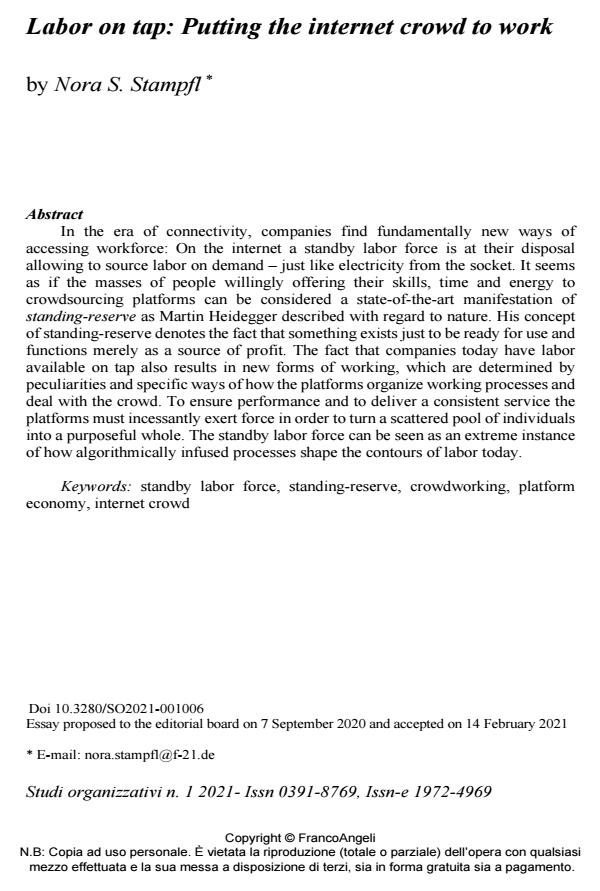Labor on tap: Putting the internet crowd to work
Journal title STUDI ORGANIZZATIVI
Author/s Nora S. Stampfl
Publishing Year 2021 Issue 2021/1 Language English
Pages 17 P. 129-145 File size 233 KB
DOI 10.3280/SO2021-001006
DOI is like a bar code for intellectual property: to have more infomation
click here
Below, you can see the article first page
If you want to buy this article in PDF format, you can do it, following the instructions to buy download credits

FrancoAngeli is member of Publishers International Linking Association, Inc (PILA), a not-for-profit association which run the CrossRef service enabling links to and from online scholarly content.
In the era of connectivity, companies find fundamentally new ways of accessing workforce: On the internet a standby labor force is at their disposal allowing to source labor on demand - just like electricity from the socket. It seems as if the masses of people willingly offering their skills, time and energy to crowdsourcing platforms can be considered a state-of-the-art manifestation of standing-reserve as Martin Heidegger described with regard to nature. His concept of standing-reserve denotes the fact that something exists just to be ready for use and functions merely as a source of profit. The fact that companies today have labor available on tap also results in new forms of working, which are determined by peculiarities and specific ways of how the platforms organize working processes and deal with the crowd. To ensure performance and to deliver a consistent service the platforms must incessantly exert force in order to turn a scattered pool of individuals into a purposeful whole. The standby labor force can be seen as an extreme instance of how algorithmically infused processes shape the contours of labor today.
Keywords: Standby labor force, standing-reserve, crowdworking, platform economy, internet crowd
- Ahrne, G., Aspers, P., Brunsson, N. (2015), “The Organization of Markets”, Organization Studies, 36(1): 7-27, DOI: 10.1177/0170840614544557
- Aneesh, A. (2002), “Technologically coded authority: The post-industrial decline in bureaucratic hierarchies”, Online working paper, -- http://web.stanford.edu/class/sts175/NewFiles/Algocratic Governance.pdf
- Bartel, C., Wrzesniewski, A., Wiesenfeld, B. (2012), “Knowing Where You Stand: Physical Isolation, Perceived Respect, and Organizational Identification Among Virtual Employees”, Organization Science, 23(3): 743-757, DOI: 10.1287/ORSC.1110.0661
- Benkler, Y. (2006), The wealth of networks. How social production transforms markets and freedom, New Haven, Yale University Press, DOI: 10.1080/08997760701193787
- Deng, X., Joshi, K.D. (2016), “Why Individuals Participate in Micro-task Crowdsourcing Work Environment: Revealing Crowdworkers’ Perceptions”, Journal of the Association for Information Systems, 17(10): 711-736.
- Fieseler, C., Bucher, E., Hoffmann, C.P. (2019), “Unfairness by Design? The Perceived Fairness of Digital Labor on Crowdworking Platforms”, Journal of Business Ethics 156(4): 987-1005,
- Grier, D.A. (2005), When Computers Were Human, Princeton University Press, DOI: 10.1515/9781400849369
- Head, S. (2005), The New Ruthless Economy: Work and Power in the Digital Age, New York, Oxford University Press,
- Heidegger, M. (1977), “The question concerning technology”, in Heidegger, M. (ed.) The question concerning technology and other essays, New York, Harper and Row, 3-35.
- Kaufmann, N., Schulze, T., Veit, D. (2011), “More than fun and money. Worker Motivation in Crowdsourcing – A Study on Mechanical Turk”. Proceedings of the 17th Americas Conference on Information Systems (AMCIS 2011): 1-11.
- Kittur, A., Nickerson, J., Bernstein, M.S., Gerber, E., Shaw, A., Zimmerman, J. et al. (2013), “The future of crowd work”. Proceedings of the ACM conference on computer supported cooperative work: 1301–1318, DOI: 10.1145/2441776.2441923
- Marx, K., Engels, F. (1968), “Ökonomisch-philosophische Manuskripte aus dem Jahre 1844” , in Werke. Ergänzungsband. Erster Teil, Berlin, Dietz Verlag, 465-588.
- Mumford, L. (1967), The myth of the machine. Technics and human development, New York, Harcourt, Brace & World.
- Munn, L. (2018), Ferocious logics: Unmaking the algorithm. Lüneburg: meson press, DOI: 10.14619/140
- Rogstadius, J., Kostakos, V., Kittur, A., Smus, B., Laredo, J, Vukovic, M. (2011), “An Assessment of Intrinsic and Extrinsic Motivation on Task Performance in Crowdsourcing Markets”. Proceedings of the International Conference on Web and Social Media (ICWSM): 17-21, DOI: 10.13140/RG.2.2.19170.94401.
- Sadowski, J. (2015), “From mega-machines to mega-algorithms”. -- [online working paper at https://thenewinquiry.com/from-mega-machines-to-mega-algorithms/]
- Schor, J. (2014), “Debating the Sharing Economy”. -- [online working paper at: http://www.greattransition.org/publication/debating-the-sharing-economy].
- Surowiecki, J. (2004), The wisdom of crowds: Why the many are smarter than the few and how collective wisdom shapes business, economies, societies, and nations, New York, Doubleday & Co.
- Tapscott, D., Williams, A. D. (2007), Wikinomics: How mass collaboration changes everything, New York, Penguin.
- Van Buren, H. J. III, Greenwood, M. (2008), “Enhancing Employee Voice: Are Voluntary Employer-Employee Partnerships Enough?”, Journal of Business Ethics, 81(1): 209–221,
- Waas, B., Liebman, W.B., Lyubarsky, A., Kezuka, K. (2017), Crowdwork – A Comparative Law Perspective, Frankfurt, Bund-Verlag.
- Zuboff, S. (1988), In The Age of the Smart Machine: The Future of Work and Power, New York, Basic Books.
- Zwolinski, M. (2007), “Sweatshops, Choice, and Exploitation”. Business Ethics Quarterly, 17(4): 689–727,
Nora S. Stampfl, Labor on tap: Putting the internet crowd to work in "STUDI ORGANIZZATIVI " 1/2021, pp 129-145, DOI: 10.3280/SO2021-001006